ES6数组的拓展
扩展运算符
扩展运算符(spread)是三个点(...)。它好比 rest 参数的逆运算,将一个数组转为用逗号分隔的参数序列。
console.log(...[1, 2, 3]) // 1 2 3 console.log(1, ...[2, 3, 4], 5) // 1 2 3 4 5 [...document.querySelectorAll('div')] // [<div>, <div>, <div>]
该运算符主要用于函数调用。
function push(array, ...items) { array.push(...items); } function add(x, y) { return x + y; } const numbers = [4, 38]; add(...numbers) // 42
上面代码中,array.push(...items)和add(...numbers)这两行,都是函数的调用,它们的都使用了扩展运算符。该运算符将一个数组,变为参数序列。
扩展运算符与正常的函数参数可以结合使用,非常灵活。
function f(v, w, x, y, z) { } const args = [0, 1]; f(-1, ...args, 2, ...[3]);
扩展运算符后面还可以放置表达式。
如果扩展运算符后面是一个空数组,则不产生任何效果。
[...[], 1] // [1]
替代函数的 apply 方法
由于扩展运算符可以展开数组,所以不再需要apply方法,将数组转为函数的参数了。
// ES5 的写法 function f(x, y, z) { // ... } var args = [0, 1, 2]; f.apply(null, args); // ES6的写法 function f(x, y, z) { // ... } let args = [0, 1, 2]; f(...args);
下面是扩展运算符取代apply方法的一个实际的例子,应用Math.max方法,简化求出一个数组最大元素的写法。
// ES5 的写法 Math.max.apply(null, [14, 3, 77]) // ES6 的写法 Math.max(...[14, 3, 77]) // 等同于 Math.max(14, 3, 77);
另一个例子是通过push函数,将一个数组添加到另一个数组的尾部


ES5 写法中,push方法的参数不能是数组,所以只好通过apply方法变通使用push方法。有了扩展运算符,就可以直接将数组传入push方法。

ES6写法

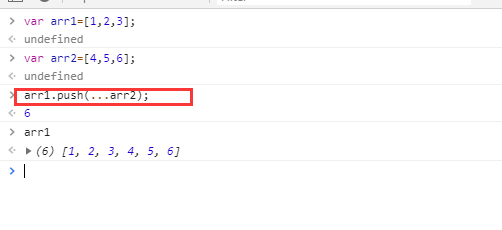
扩展运算符的应用
(1)复制数组
数组是复合的数据类型,直接复制的话,只是复制了指向底层数据结构的指针,而不是克隆一个全新的数组。
a2并不是a1的克隆,而是指向同一份数据的另一个指针。修改a2,会直接导致a1的变化。
const a1 = [1, 2]; const a2 = a1; a2[0] = 2; a1 // [2, 2]
ES5 只能用变通方法来复制数组。
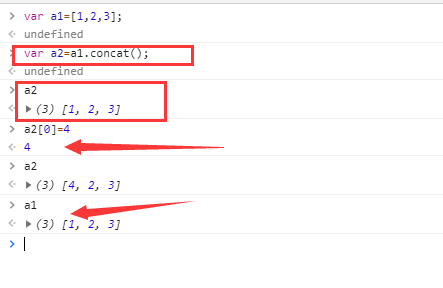
扩展运算符提供了复制数组的简便写法。
const a1 = [1, 2]; // 写法一 const a2 = [...a1]; // 写法二 const [...a2] = a1;
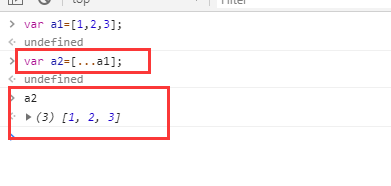
(2)合并数组
扩展运算符提供了数组合并的新写法。
const arr1 = ['a', 'b']; const arr2 = ['c']; const arr3 = ['d', 'e']; // ES5 的合并数组 arr1.concat(arr2, arr3); // [ 'a', 'b', 'c', 'd', 'e' ] // ES6 的合并数组 [...arr1, ...arr2, ...arr3] // [ 'a', 'b', 'c', 'd', 'e' ]

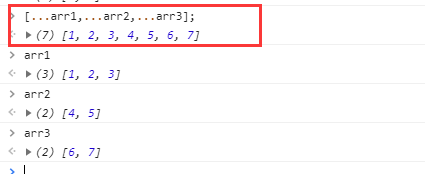
不过,这两种方法都是浅拷贝,使用的时候需要注意。
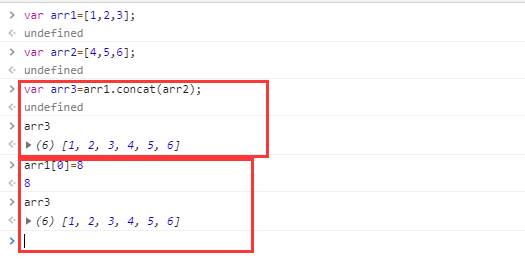
const a1 = [{ foo: 1 }];
const a2 = [{ bar: 2 }];
const a3 = a1.concat(a2);
const a4 = [...a1, ...a2];
a3[0] === a1[0] // true
a4[0] === a1[0] // true
(3)与解构赋值结合
// ES5 a = list[0], rest = list.slice(1) // ES6 [a, ...rest] = list
const [first, ...rest] = [1, 2, 3, 4, 5]; first // 1 rest // [2, 3, 4, 5] const [first, ...rest] = []; first // undefined rest // [] const [first, ...rest] = ["foo"]; first // "foo" rest // []
(4)字符串
扩展运算符还可以将字符串转为真正的数组
[...'hello'] // [ "h", "e", "l", "l", "o" ]
(5)实现了 Iterator 接口的对象
任何 Iterator 接口的对象(参阅 Iterator 一章),都可以用扩展运算符转为真正的数组。
querySelectorAll方法返回的是一个nodeList对象。它不是数组,而是一个类似数组的对象。这时,扩展运算符可以将其转为真正的数组,原因就在于NodeList对象实现了 Iterator 。
let nodeList = document.querySelectorAll('div');
let array = [...nodeList];
对于那些没有部署 Iterator 接口的类似数组的对象,扩展运算符就无法将其转为真正的数组。
let arrayLike = { '0': 'a', '1': 'b', '2': 'c', length: 3 }; // TypeError: Cannot spread non-iterable object. let arr = [...arrayLike];
上面代码中,arrayLike是一个类似数组的对象,但是没有部署 Iterator 接口,扩展运算符就会报错。这时,可以改为使用Array.from方法将arrayLike转为真正的数组。
(6)Map 和 Set 结构,Generator 函数
扩展运算符内部调用的是数据结构的 Iterator 接口,因此只要具有 Iterator 接口的对象,都可以使用扩展运算符,比如 Map 结构。
let map = new Map([ [1, 'one'], [2, 'two'], [3, 'three'], ]); let arr = [...map.keys()]; // [1, 2, 3]
Generator 函数运行后,返回一个遍历器对象,因此也可以使用扩展运算符。
变量go是一个 Generator 函数,执行后返回的是一个遍历器对象,对这个遍历器对象执行扩展运算符,就会将内部遍历得到的值,转为一个数组。
const go = function*(){ yield 1; yield 2; yield 3; }; [...go()] // [1, 2, 3]
如果对没有 Iterator 接口的对象,使用扩展运算符,将会报错。
const obj = {a: 1, b: 2};
let arr = [...obj]; // TypeError: Cannot spread non-iterable object
Array.from()
Array.from方法用于将两类对象转为真正的数组:类似数组的对象(array-like object)和可遍历(iterable)的对象(包括 ES6 新增的数据结构 Set 和 Map)。
下面是一个类似数组的对象,Array.from将它转为真正的数组。
let arrayLike = { '0': 'a', '1': 'b', '2': 'c', length: 3 }; // ES5的写法 var arr1 = [].slice.call(arrayLike); // ['a', 'b', 'c'] // ES6的写法 let arr2 = Array.from(arrayLike); // ['a', 'b', 'c']
实际应用中,常见的类似数组的对象是 DOM 操作返回的 NodeList 集合,以及函数内部的arguments对象。Array.from都可以将它们转为真正的数组。
// NodeList对象 let ps = document.querySelectorAll('p'); Array.from(ps).filter(p => { return p.textContent.length > 100; }); // arguments对象 function foo() { var args = Array.from(arguments); // ... }
只要是部署了 Iterator 接口的数据结构,Array.from都能将其转为数组。
字符串和 Set 结构都具有 Iterator 接口,因此可以被Array.from转为真正的数组。
Array.from('hello')
// ['h', 'e', 'l', 'l', 'o']
let namesSet = new Set(['a', 'b'])
Array.from(namesSet) // ['a', 'b']
值得提醒的是,扩展运算符(...)也可以将某些数据结构转为数组。
// arguments对象 function foo() { const args = [...arguments]; } // NodeList对象 [...document.querySelectorAll('div')]
扩展运算符背后调用的是遍历器接口(Symbol.iterator),如果一个对象没有部署这个接口,就无法转换。Array.from方法还支持类似数组的对象。所谓类似数组的对象,本质特征只有一点,即必须有length属性。因此,任何有length属性的对象,都可以通过Array.from方法转为数组,而此时扩展运算符就无法转换。
Array.from({ length: 3 });
// [ undefined, undefined, undefined ]
对于还没有部署该方法的浏览器,可以用Array.prototype.slice方法替代
const toArray = (() => Array.from ? Array.from : obj => [].slice.call(obj) )();
Array.from还可以接受第二个参数,作用类似于数组的map方法,用来对每个元素进行处理,将处理后的值放入返回的数组。
Array.from(arrayLike, x => x * x); // 等同于 Array.from(arrayLike).map(x => x * x); Array.from([1, 2, 3], (x) => x * x) // [1, 4, 9]
取出一组 DOM 节点的文本内容。
let spans = document.querySelectorAll('span.name');
// map()
let names1 = Array.prototype.map.call(spans, s => s.textContent);
// Array.from()
let names2 = Array.from(spans, s => s.textContent)
将数组中布尔值为false的成员转为0。
Array.from([1, , 2, , 3], (n) => n || 0) // [1, 0, 2, 0, 3]
是返回各种数据的类型。
function typesOf () { return Array.from(arguments, value => typeof value) } typesOf(null, [], NaN) // ['object', 'object', 'number']
Array.from()可以将各种值转为真正的数组,并且还提供map功能。这实际上意味着,只要有一个原始的数据结构,你就可以先对它的值进行处理,然后转成规范的数组结构,进而就可以使用数量众多的数组方法。
Array.from的第一个参数指定了第二个参数运行的次数。这种特性可以让该方法的用法变得非常灵活。
Array.from({ length: 2 }, () => 'jack')
// ['jack', 'jack']
Array.of()
Array.of方法用于将一组值,转换为数组。
Array.of(3, 11, 8) // [3,11,8] Array.of(3) // [3] Array.of(3).length // 1
这个方法的主要目的,是弥补数组构造函数Array()的不足。因为参数个数的不同,会导致Array()的行为有差异。
Array方法没有参数、一个参数、三个参数时,返回结果都不一样。只有当参数个数不少于 2 个时,Array()才会返回由参数组成的新数组。参数个数只有一个时,实际上是指定数组的长度。
Array() // [] Array(3) // [, , ,] Array(3, 11, 8) // [3, 11, 8]
Array.of基本上可以用来替代Array()或new Array(),并且不存在由于参数不同而导致的重载。它的行为非常统一。
Array.of() // [] Array.of(undefined) // [undefined] Array.of(1) // [1] Array.of(1, 2) // [1, 2]
Array.of总是返回参数值组成的数组。如果没有参数,就返回一个空数组。
Array.of方法可以用下面的代码模拟实现。
function ArrayOf(){ return [].slice.call(arguments); }
数组实例的 copyWithin()
数组实例的copyWithin方法,在当前数组内部,将指定位置的成员复制到其他位置(会覆盖原有成员),然后返回当前数组。也就是说,使用这个方法,会修改当前数组。
Array.prototype.copyWithin(target, start = 0, end = this.length)
这三个参数都应该是数值,如果不是,会自动转为数值。
[1, 2, 3, 4, 5].copyWithin(0, 3) // [4, 5, 3, 4, 5]
上面代码表示将从 3 号位直到数组结束的成员(4 和 5),复制到从 0 号位开始的位置,结果覆盖了原来的 1 和 2。
// 将3号位复制到0号位 [1, 2, 3, 4, 5].copyWithin(0, 3, 4) // [4, 2, 3, 4, 5] // -2相当于3号位,-1相当于4号位 [1, 2, 3, 4, 5].copyWithin(0, -2, -1) // [4, 2, 3, 4, 5] // 将3号位复制到0号位 [].copyWithin.call({length: 5, 3: 1}, 0, 3) // {0: 1, 3: 1, length: 5} // 将2号位到数组结束,复制到0号位 let i32a = new Int32Array([1, 2, 3, 4, 5]); i32a.copyWithin(0, 2); // Int32Array [3, 4, 5, 4, 5] // 对于没有部署 TypedArray 的 copyWithin 方法的平台 // 需要采用下面的写法 [].copyWithin.call(new Int32Array([1, 2, 3, 4, 5]), 0, 3, 4); // Int32Array [4, 2, 3, 4, 5]
数组实例的 find() 和 findIndex()
数组实例的find方法,用于找出第一个符合条件的数组成员。它的参数是一个回调函数,所有数组成员依次执行该回调函数,直到找出第一个返回值为true的成员,然后返回该成员。如果没有符合条件的成员,则返回undefined。
找出数组中第一个小于 0 的成员。
[1, 4, -5, 10].find((n) => n < 0) // -5
find方法的回调函数可以接受三个参数,依次为当前的值、当前的位置和原数组。
[1, 5, 10, 15].find(function(value, index, arr) { return value > 9; }) // 10
数组实例的findIndex方法的用法与find方法非常类似,返回第一个符合条件的数组成员的位置,如果所有成员都不符合条件,则返回-1。
[1, 5, 10, 15].findIndex(function(value, index, arr) { return value > 9; }) // 2
这两个方法都可以接受第二个参数,用来绑定回调函数的this对象。find函数接收了第二个参数person对象,回调函数中的this对象指向person对象。
function f(v){ return v > this.age; } let person = {name: 'John', age: 20}; [10, 12, 26, 15].find(f, person); // 26
另外,这两个方法都可以发现NaN,弥补了数组的indexOf方法的不足。indexOf方法无法识别数组的NaN成员,但是findIndex方法可以借助Object.is方法做到。
[NaN].indexOf(NaN) // -1 [NaN].findIndex(y => Object.is(NaN, y)) // 0
数组实例的 fill()
fill方法使用给定值,填充一个数组 fill方法用于空数组的初始化非常方便。数组中已有的元素,会被全部抹去。
['a', 'b', 'c'].fill(7) // [7, 7, 7] new Array(3).fill(7) // [7, 7, 7]
fill方法还可以接受第二个和第三个参数,用于指定填充的起始位置和结束位置。fill方法从 1 号位开始,向原数组填充 7,到 2 号位之前结束。
['a', 'b', 'c'].fill(7, 1, 2) // ['a', 7, 'c']
数组实例的 entries(),keys() 和 values()
ES6 提供三个新的方法——entries(),keys()和values()——用于遍历数组。它们都返回一个遍历器对象(详见《Iterator》一章),可以用for...of循环进行遍历,唯一的区别是keys()是对键名的遍历、values()是对键值的遍历,entries()是对键值对的遍历。
for (let index of ['a', 'b'].keys()) { console.log(index); } // 0 // 1 for (let elem of ['a', 'b'].values()) { console.log(elem); } // 'a' // 'b' for (let [index, elem] of ['a', 'b'].entries()) { console.log(index, elem); } // 0 "a" // 1 "b"
数组实例的 includes()
Array.prototype.includes方法返回一个布尔值,表示某个数组是否包含给定的值,与字符串的includes方法类似。ES2016 引入了该方法
[1, 2, 3].includes(2) // true [1, 2, 3].includes(4) // false [1, 2, NaN].includes(NaN) // true
该方法的第二个参数表示搜索的起始位置,默认为0。如果第二个参数为负数,则表示倒数的位置,如果这时它大于数组长度(比如第二个参数为-4,但数组长度为3),则会重置为从0开始。
[1, 2, 3].includes(3, 3); // false [1, 2, 3].includes(3, -1); // true
没有该方法之前,我们通常使用数组的indexOf方法,检查是否包含某个值。
if (arr.indexOf(el) !== -1) { // ... }
indexOf方法有两个缺点,一是不够语义化,它的含义是找到参数值的第一个出现位置,所以要去比较是否不等于-1,表达起来不够直观。二是,它内部使用严格相等运算符(===)进行判断,这会导致对NaN的误判。
[NaN].indexOf(NaN)
// -1
includes使用的是不一样的判断算法,就没有这个问题。
[NaN].includes(NaN) // true
下面代码用来检查当前环境是否支持该方法,如果不支持,部署一个简易的替代版本。
const contains = (() => Array.prototype.includes ? (arr, value) => arr.includes(value) : (arr, value) => arr.some(el => el === value) )(); contains(['foo', 'bar'], 'baz'); // => false
Map 和 Set 数据结构有一个has方法,需要注意与includes区分。
Map 结构的has方法,是用来查找键名的,比如Map.prototype.has(key)、WeakMap.prototype.has(key)、Reflect.has(target, propertyKey)。
Set 结构的has方法,是用来查找值的,比如Set.prototype.has(value)、WeakSet.prototype.has(value)。
数组的空位
数组的空位指,数组的某一个位置没有任何值。比如,Array构造函数返回的数组都是空位。
Array(3)返回一个具有 3 个空位的数组。注意,空位不是undefined,一个位置的值等于undefined,依然是有值的。
Array(3) // [, , ,]
空位是没有任何值,in运算符可以说明这一点。
0 in [undefined, undefined, undefined] // true 0 in [, , ,] // false
上面代码说明,第一个数组的 0 号位置是有值的,第二个数组的 0 号位置没有值。
ES5 对空位的处理,已经很不一致了,大多数情况下会忽略空位。
forEach(), filter(), reduce(), every() 和some()都会跳过空位。
map()会跳过空位,但会保留这个值
join()和toString()会将空位视为undefined,而undefined和null会被处理成空字符串。
// forEach方法 [,'a'].forEach((x,i) => console.log(i)); // 1 // filter方法 ['a',,'b'].filter(x => true) // ['a','b'] // every方法 [,'a'].every(x => x==='a') // true // reduce方法 [1,,2].reduce((x,y) => return x+y) // 3 // some方法 [,'a'].some(x => x !== 'a') // false // map方法 [,'a'].map(x => 1) // [,1] // join方法 [,'a',undefined,null].join('#') // "#a##" // toString方法 [,'a',undefined,null].toString() // ",a,,"



 浙公网安备 33010602011771号
浙公网安备 33010602011771号